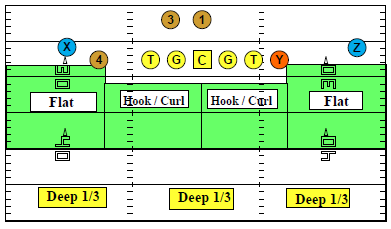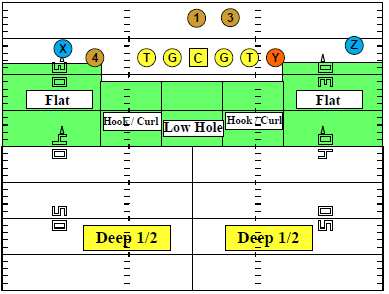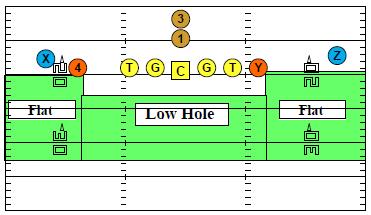Field Identification Divided Into Drop & Coverage Zones
Terms:
4 Under:
4 Zone Defenders In The Flats
and Hook / Curl Zones Covering
From The L.O.S. to 13 Yards.

3 Deep:
3 deep Zone defenders Splitting
The Field Into 1/3’s. Covering
From 13 Yards To The Goal Line.
Landmarks:
Flat (No Low Hole)
Middle Of The Numbers,
10 yards From the L.O.S.
Hook / Curl (No Low Hole)
2 yards Inside The Hash,
10 Yards From The L.O.S.
5 Under:
5 Zone Defenders in The Flats
Hook / Curl & Low Hole Zones
Covering From The L.O.S. To 13 Yards
2 Deep
2 Zone Defenders Splitting
The Field In Half. Covering
From 13 Yards To The Goal Line

Landmarks:
Flat
Bottom Of The Numbers,
10 Yards From L.O.S.
Hook / Curl
2 Yards Outside The Hash, 10 Yards
From L.O.S.
Low Hole
Split The Hash Marks, 10 Yards
From The L.O.S.
3 Under
3 Zone Defenders in The Flats
and Low Hole Zones Covering
From The L.O.S. To 13 Yards.
Landmarks:
Flat (No Hook / Curl)
Top Of The Numbers, 10 Yards From L.O.S.
Low Hole
Split The Hash Marks, 10 Yards From L.O.S.

1 Under: 1 Low hole player playing the
entire width of the field from the L.O.S. to
13 yards deep. All other underneath coverage
is manned up.
2 Under: A defender in each Hook / Curl playing
half the field from the L.O.S. to 13 yards deep.
All other underneath coverage is manned up.
Centerfield: Deep middle help playing the entire
width of the field keeping all receivers in front of you.

The diagram above breaks the field down into zone areas. Each area of the field is broken down into areas of responsibility. You will always have two areas of responsibility for your coverages, an underneath coverage which extends fifteen yards deep from the line of scrimmage and deep coverage that takes you fifteen yards or deeper.
When playing underneath flat coverage a defender needs not get any closer to the sideline than 6 yards, this becomes his landmark for breaking down on a receiver in his area and that area is termed the Flat area of responsibility. When in any type of deep coverage the secondary defender needs not get any closer than 9 yards to the sideline, this becomes his landmark.
The reason for 6 yards in underneath coverage is because it is considered that area when the ball is thrown the defender can still react to the break on the ball. The depth of 9 yards on deep coverage is different because the ball is in the air longer thus, giving the deep defender longer to recover and break on the ball.
Part 2 of this post will be on the site on Wednesday May 10, 2017.
To read part 2, click here: Drop Zones and Coverage Part 2
About the Author of this post:
Jerry Campbell has over 30 years of high school and college coaching experience. He has experience as a head coach, offensive coordinator, and various position coaches. He has written numerous football coaching articles in various publications, is the author of over 30 books on coaching football, and has produced 12 coaching video series. Additionally, he is a nationally sought after speaker on the coaching clinic circuit.